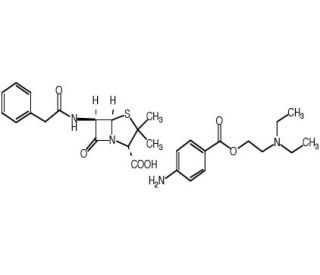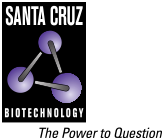
Click on image or enlarge button to enlarge

Penicillin G procaine: sc-205797
Penicillin G procaine (CAS 6130-64-9)
Alternate Names:
Duracillin; Bicillin C-R; Aquacilina
Application:
Penicillin G procaine is a combination of Penicillin G and Procaine
CAS Number:
6130-64-9
Purity:
≥98%
Molecular Weight:
570.70
Molecular Formula:
C29H38N4O6S
For Research Use Only. Not Intended for Diagnostic or Therapeutic Use.
* Refer to Certificate of Analysis for lot specific data.
QUICK LINKS
Ordering Information
Description
Technical Information
Safety Information
SDS & Certificate of Analysis

Penicillin G procaine is a combination of penicillin G and procaine. Penicillin G is a hydrophobic, β-lactam antibiotic produced by Penicillium spp.. As an antibiotic, penicillin G is noted to posses effectiveness mainly against gram-positive organisms. Some gram-negative organisms such as Neiserria gonorrhoeae and Neiserria meningitidis are also reported to be susceptible to penicillin G. Penicillin G is also known as benzylpenicillin and contains a 6′ phenylacetyl side chain. In acid aqueous solutions, penicillin is reported to decompose into penillic acid and penilloic acid.
Procaine is a noted sodium channel blocker with a variety of inhibitory effects. In skeletal muscle, procaine has been reported to inhibit calcium-induced calcium release (CICR). Procaine is also noted to act as a DNA methylation inhibitor and to cause demethylation and reactivation of methylation-silenced genes such as RARβ and GSTP1. WIF-1 is noted to be reactivated in a cancer cell line and to downregulate the Wnt canonical pathway. In studies utilizing a neuroblastoma cell line (SHEP), procaine is reported to induce neuronal apoptosis in a manner correlated with lipid solubility of the compound. In an adult mouse muscle cell line (HEK293), the presence of procaine is reported to potently inhibit AChR (nicotinic acetylcholine receptors).
Penicillin G is also available alone (sc-344973) and in salt forms such as Penicillin G sodium (sc-257971) and penicillin G potassium (sc-255411). Procaine is available alone (sc-296134) and in its salt form, procaine HCl (sc-250776).
Procaine is a noted sodium channel blocker with a variety of inhibitory effects. In skeletal muscle, procaine has been reported to inhibit calcium-induced calcium release (CICR). Procaine is also noted to act as a DNA methylation inhibitor and to cause demethylation and reactivation of methylation-silenced genes such as RARβ and GSTP1. WIF-1 is noted to be reactivated in a cancer cell line and to downregulate the Wnt canonical pathway. In studies utilizing a neuroblastoma cell line (SHEP), procaine is reported to induce neuronal apoptosis in a manner correlated with lipid solubility of the compound. In an adult mouse muscle cell line (HEK293), the presence of procaine is reported to potently inhibit AChR (nicotinic acetylcholine receptors).
Penicillin G is also available alone (sc-344973) and in salt forms such as Penicillin G sodium (sc-257971) and penicillin G potassium (sc-255411). Procaine is available alone (sc-296134) and in its salt form, procaine HCl (sc-250776).
References:
- MECHANISM OF DEGRADATION OF PENICILLIN G IN ACIDIC SOLUTION. | SCHWARTZ, MA. 1965. J Pharm Sci. 54: 472-3. PMID: 14301592
- Production of beta-lactam antibiotics and its regulation. | Demain, AL. 1991. Proc Natl Sci Counc Repub China B. 15: 251-65. PMID: 1815263
- beta-Lactamases- the Threat Renews. | Livermore, DM. 2009. Curr Protein Pept Sci. 10: 397-400. PMID: 19538149
- Apoptosis induction by different local anaesthetics in a neuroblastoma cell line. | Werdehausen, R., et al. 2009. Br J Anaesth. 103: 711-8. PMID: 19700777
- Calcium-induced calcium release in skeletal muscle. | Endo, M. 2009. Physiol Rev. 89: 1153-76. PMID: 19789379
- Procaine and procainamide inhibit the Wnt canonical pathway by promoter demethylation of WIF-1 in lung cancer cells. | Gao, Z., et al. 2009. Oncol Rep. 22: 1479-84. PMID: 19885602
- The effect of local anesthetics on the inhibition of adult muscle-type nicotinic acetylcholine receptors by nondepolarizing muscle relaxants. | Wang, H., et al. 2010. Eur J Pharmacol. 630: 29-33. PMID: 20045405
- A wasp manipulates neuronal activity in the sub-esophageal ganglion to decrease the drive for walking in its cockroach prey. | Gal, R. and Libersat, F. 2010. PLoS One. 5: e10019. PMID: 20383324
- Evaluation of the Impact of Antimicrobial Use Protocols in Porcine Reproductive and Respiratory Syndrome Virus-Infected Swine on Phenotypic Antimicrobial Resistance Patterns. | Odland, CA., et al. 2022. Appl Environ Microbiol. 88: e0097021. PMID: 34644164
- Safety of Antimicrobials for Postexposure Prophylaxis and Treatment of Anthrax: A Review. | Parker, CM., et al. 2022. Clin Infect Dis. 75: S417-S431. PMID: 36251549
- Comparison of the effects of tylosin and tilmicosin as a systemic treatment of dry Holstein cows. | Abani, S., et al. 2022. Vet Res Forum. 13: 495-499. PMID: 36686881
- Optic neuritis presented as the only manifestation of neurosyphilis. | Roy, T., et al. 2023. Oman J Ophthalmol. 16: 161-164. PMID: 37007240
- Penicillin G procaine: a possible cause of embryonic death in swine. | Nurmio, P. and Schulman, A. 1980. Vet Rec. 106: 97-8. PMID: 7361408
